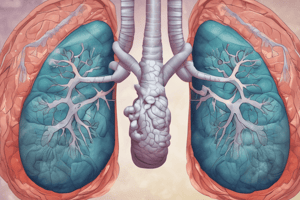Podcast
Questions and Answers
What can cause absorptive atelectasis?
What can cause absorptive atelectasis?
- Abdominal distension
- Pleural effusion
- Decreased levels of surfactant (correct)
- Airway tumors
What is a risk factor for atelectasis?
What is a risk factor for atelectasis?
- Bronchoscopy
- Abdominal surgery (correct)
- Early ambulation
- Opioid withdrawal
What is a clinical manifestation of atelectasis?
What is a clinical manifestation of atelectasis?
- Decreased cough
- Decreased fever
- Increased sputum production (correct)
- Decreased dyspnea
What is a type of atelectasis?
What is a type of atelectasis?
What can help prevent atelectasis?
What can help prevent atelectasis?
What is a diagnostic study for atelectasis?
What is a diagnostic study for atelectasis?
What can cause compressive atelectasis?
What can cause compressive atelectasis?
What is a common location for atelectasis to occur?
What is a common location for atelectasis to occur?
What is the primary goal of chest physiotherapy in patients with pneumonia?
What is the primary goal of chest physiotherapy in patients with pneumonia?
Which of the following is a risk factor for community-acquired pneumonia (CAP)?
Which of the following is a risk factor for community-acquired pneumonia (CAP)?
What is the primary cause of hospital-acquired pneumonia (HAP)?
What is the primary cause of hospital-acquired pneumonia (HAP)?
When should a patient with pneumonia be hospitalized?
When should a patient with pneumonia be hospitalized?
What is the goal of incentive spirometry in patients with pneumonia?
What is the goal of incentive spirometry in patients with pneumonia?
What is the definition of healthcare-associated pneumonia (HCAP)?
What is the definition of healthcare-associated pneumonia (HCAP)?
What is the pathophysiology of pneumonia?
What is the pathophysiology of pneumonia?
What is the risk factor for pneumonia mentioned in the content?
What is the risk factor for pneumonia mentioned in the content?
What can cause acute inflammatory response in the lung parenchyma?
What can cause acute inflammatory response in the lung parenchyma?
What is a common risk factor for atelectasis?
What is a common risk factor for atelectasis?
What is a characteristic of noncardiogenic pulmonary edema?
What is a characteristic of noncardiogenic pulmonary edema?
What is a clinical manifestation of pulmonary edema?
What is a clinical manifestation of pulmonary edema?
What is a normal amount of fluid in the pleural space?
What is a normal amount of fluid in the pleural space?
What is a characteristic of transudate fluid?
What is a characteristic of transudate fluid?
What is a treatment for pulmonary edema?
What is a treatment for pulmonary edema?
What is a clinical manifestation of pleural effusion?
What is a clinical manifestation of pleural effusion?
What is a common trigger for asthma attacks?
What is a common trigger for asthma attacks?
Which of the following is a predisposing factor for asthma?
Which of the following is a predisposing factor for asthma?
What is a characteristic of a severe asthma attack?
What is a characteristic of a severe asthma attack?
What is the maximum flow rate for nasal cannula?
What is the maximum flow rate for nasal cannula?
What is the primary cause of COPD?
What is the primary cause of COPD?
What is the most severe type of pneumothorax?
What is the most severe type of pneumothorax?
What is a major risk factor for ARDS?
What is a major risk factor for ARDS?
What is a common symptom of cancer of the larynx?
What is a common symptom of cancer of the larynx?
What is a common feature of CXR/CT findings in patients with Sepsis, Aspiration, Trauma, Covid?
What is a common feature of CXR/CT findings in patients with Sepsis, Aspiration, Trauma, Covid?
What is the characteristic of Chronic Bronchitis?
What is the characteristic of Chronic Bronchitis?
What is the most common cause of Asthma?
What is the most common cause of Asthma?
What is the goal of oxygen therapy in COPD?
What is the goal of oxygen therapy in COPD?
What is a characteristic of Sepsis, Aspiration, Trauma, Covid?
What is a characteristic of Sepsis, Aspiration, Trauma, Covid?
What is a management strategy for COPD?
What is a management strategy for COPD?
What is a complication of COPD?
What is a complication of COPD?
What is the primary goal of oxygen therapy in COPD?
What is the primary goal of oxygen therapy in COPD?
Flashcards are hidden until you start studying
Study Notes
Lower Respiratory Tract Disorders
- Atelectasis:
- Collapse or closure of alveoli leading to loss of lung volume
- Types:
- Absorptive atelectasis: worst scenario in respiratory assessment, occurs due to surfactant ratio imbalance or decreased levels of inhaled nitrogen
- Compressive atelectasis: external forces compressing on pleural lung tissue
- Obstructive atelectasis: blockage of air passage to and from alveoli
- Clinical manifestations:
- Increasing dyspnea, sputum production, cough, fever, egophony
- Risk factors:
- Surgery, opioid use, abdominal distension, NG tube
- Diagnostic studies:
- O2 sat, CXR, CT chest, ABGs, Bronchoscopy
- Prevention:
- Move and ambulate, deep breathing, coughing, incentive spirometer, chest physiotherapy, nebulizer
Pneumonia
- Inflammation of lung parenchyma caused by microorganisms
- Classification:
- Community-acquired pneumonia (CAP): Streptococcus pneumoniae, risk factors include previous PNA, smoking, household >10 people, contact with children
- Hospital-acquired pneumonia (HAP) and ventilator-associated pneumonia (VAP): Enterobacter species, risk factors include prolonged intubation, exposure to antibiotics
- Healthcare-associated pneumonia (HCAP): nonhospitalized patients with extensive healthcare contact
- Risk factors:
- Altered LOC, neurological disorders, dysphagia, recumbent positioning, NG tubes, advanced age, mechanical ventilation
- Prevention:
- High-risk patients: high Fowler's position, early mobilization, deep breathing, coughing, NO straws, thickened liquids, assessing NG tube with CXR
Pulmonary Edema
- Abnormal accumulation of fluid in lung tissue/alveolar space
- Types:
- Acute pulmonary edema or "Flash Edema": life-threatening
- Noncardiogenic: ARDS, neurogenic, reexpansion, negative pressure
- Cardiogenic: left-sided heart failure
- Clinical manifestations:
- Severe respiratory distress, foamy/frothy blood-tinged sputum, wheezing and crackling in the lungs
- Treatment:
- O2 therapy, intubation or mechanical ventilation, vasodilators, ACE inhibitors, diuretics, digoxin, opioids
Pleural Effusion
- Abnormal collection of fluid in the pleural space
- Types:
- Transudate fluid: imbalance of oncotic pressures, nondiseased pleura
- Exudate fluid: inflammatory bacterial products or tumors; empyemas
- Clinical manifestations:
- Dyspnea, tachypnea, sharp pleuritic chest pain, decreased/absent breath sounds
- Diagnostic:
- CXR/CT: similar to cardiogenic pulmonary edema, bilateral patchy infiltrates, and increased alveolar dead space
Chronic Obstructive Pulmonary Disease (COPD)
- Chronic and progressive expiratory airflow limitations
- Pathophysiology:
- Airflow restriction due to emphysema and chronic bronchitis
- Risk factors:
- Tobacco, exposure to particles, genetic factors, cooking in poorly ventilated areas
- Clinical manifestations:
- Dyspnea, chronic cough > 3 months, sputum production, barrel chest, wheezing, pursed lip breathing, digital clubbing
- Management:
- Stop smoking, exercise, nutrition, PNA/Influenza vaccinations, bronchodilators, inhaled corticosteroids, diuretics, phosphodiesterase-4 inhibitors, alpha-1 replacement therapy, antibiotics, oxygen therapy
Asthma
- Common, obstruction of small airways
- Pathophysiology:
- Predisposing factors: atopy, female sex
- Causal factors: indoor/outdoor allergens, occupational
- Clinical manifestations:
- Worse at night, cough, dyspnea, wheezing, chest tightness, tachycardia
- Management:
- Patient education, bronchodilators, inhaled corticosteroids, oral steroids, leukotriene receptor antagonists
Studying That Suits You
Use AI to generate personalized quizzes and flashcards to suit your learning preferences.




